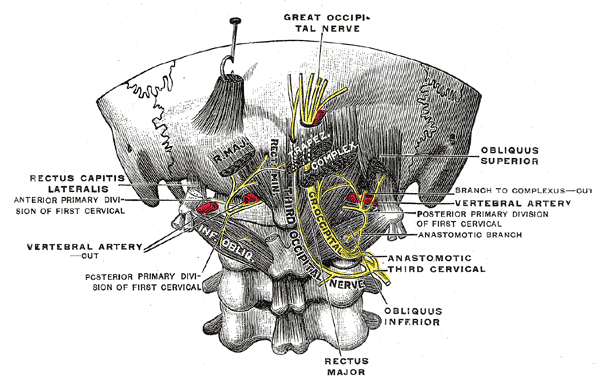Head pain—headache and facial pain included—is some of the most debilitating pain a person can experience. There are a variety of causes of this type of pain, but one of them in particular can be difficult to properly diagnose. What is occipital neuralgia? Here’s what you need to know about this serious pain condition.
What is occipital neuralgia?
Occipital neuralgia is a type of head and facial pain that originates in the occipital nerve. Your occipital nerve is actually a group of three nerves that originates from the cervical spine (the neck).
They include the:
- Greater occipital nerve (GON): Innervates the back of the scalp, the ear, and a portion of the skin
- Lesser (small) occipital nerve (LON): Has three divisions (auricular, mastoid, and occipital branches) that innervate the head behind the ear and where the ear attaches to the head
- Third (least) occipital nerve (TON): Runs on either side of the cervical vertebrae and innervates the back of the head
Occipital neuralgia is the pain condition that results when these nerves are damaged or compressed. This damage or compression may occur to the nerve itself, or it may be a result of other injuries that involves nearby nerves. For example, injuries to the neck and shoulders can lead to occipital neuralgia.
What causes occipital neuralgia?
Occipital neuralgia causes can all be traced back to irritation or inflammation of the occipital nerves. And, while this condition itself is not a life-threatening condition, the pain of it can make daily life incredibly challenging.
But what causes this irritation? These are some of the more common causes.
Whiplash
Whiplash is a traumatic injury in which the head and neck is thrust forward until it reaches the end of its range of motion before snapping violently back. This motion can cause severe injury to the tendons, ligaments, and muscles of the neck.
This is one of the most common causes of occipital neuralgia.
Injury to the head and neck
Any injury other than whiplash can cause damage to the occipital nerve and result in occipital neuralgia.
This may occur during a fall or an injury while playing sports.
Stiff neck muscles
Stiff neck muscles may be the result of an ongoing forward head position.
If you work in a job that has you staring at a screen or looking downwards on a regular basis, you may experience stiff neck muscles that begin to compress one or more occipital nerves.
Arthritis
All joints in the body are susceptible to arthritis, and the cervical spine is no different.
Inflammation due to wear and tear, or due to autoimmune conditions, can cause the characteristic pain of occipital neuralgia.
Gout
Gout is not a common cause of occipital neuralgia, but it can occur.
It’s is a type of arthritis that occurs when uric acid collects in the joints. This collection can cause inflammation and pain.
Diabetes
Those with diabetes are at an increased risk of headaches and head pain related to damage to their vascular system.
This is because poorly controlled diabetes can result in highly variable blood sugar that damages veins. Although diabetic pain is usually confined to the lower extremities, it can occur in the form of occipital neuralgia as well.
Inflamed blood vessels
This is not a common cause of occipital neuralgia, but it can occur.
Inflamed blood vessels anywhere on the neck or scalp can press on the occipital nerve, causing symptoms.
Tumors and infections
Tumors along the neck and spine or infections in that same region may result in nerve compression or inflammation along the muscles of the neck and shoulders. These two causes of occipital neuralgia are rare.
Do I have occipital neuralgia?
Now that we’ve answered the question “what is occipital neuralgia?” it’s time to look at who is most at risk for developing this condition.
Common risk factors for occipital neuralgia include those with a history of:
- Infection of muscles and nerves in the neck, shoulders, and upper back
- Trauma to the neck or head (e.g., car accident)
- Cervical osteoarthritis (osteoarthritis in the neck)
Further, it’s important to recognize occipital neuralgia symptoms for the best chance of treatment success. By getting treatment early, you can help reduce worsening of symptoms.
Occipital neuralgia symptoms
The most common occipital neuralgia symptoms include:
- Pain: Pain can be sudden, severe, and sharp. It can occur behind the eye, at the base of the head, and on one side of the head. This pain can have a variety of qualities. Most patients describe it as sharp and sudden. Pain can also radiate towards the face as the condition worsens.
- Sensitivity: Sensitivity to all forms of stimulation is common. This includes sensitivity to light and touch. Tenderness to touch is usually felt directly over the involved nerve. Simple acts like brushing your hair can become excruciating.
- Issues with balance, coordination, and speech: Dizziness and vertigo are troubling symptoms that make daily life harder. Blurry vision contributes to difficulties with balance as well. Slurred speech is one of the more troubling symptoms. When combined with balance issues, it can resemble the aftermath of a stroke.
- Nausea and vomiting: It makes sense that dizziness and vertigo can lead to nearly constant nausea and, in some severe cases, vomiting.
- Tightness in the neck: Increasing tightness in the neck (with or without pain) might be the first symptom of occipital neuralgia. It can occur gradually or come on suddenly after an injury, almost like a muscle spasm.
- Dental pain: The occipital nerve innervates the area around the ear. As with ear infection, patients with occipital neuralgia may feel pain in their back teeth.
These symptoms alone can indicate other conditions, but together they provide the landmarks for an occipital neuralgia diagnosis.
Diagnosing occipital neuralgia
Some occipital neuralgia symptoms are similar to migraine symptoms. This in and of itself makes diagnosing occipital neuralgia quite challenging. There is no singular test that diagnoses this condition, so your doctor will proceed with a standard course of testing to eliminate some conditions and begin to narrow down the possibilities.
These tests may include:
- Physical examination
- Neurological testing
- Magnetic resonance imaging (MRI)
- Computed tomography scan (CT or CAT scan)
Occipital nerve blocks are also used as not only a treatment (see below) but also as a diagnostic tool. If a block in the occipital nerve relieves your pain, it can help confirm the diagnosis.
How do you treat occipital neuralgia?
Occipital neuralgia treatments aim at reducing symptoms while treating underlying causes of pain as well. As everyone’s pain (and situation) is different, not everyone will find relief with every treatment.
The best course of action is to work closely with your pain specialist to find a comprehensive treatment plan that addresses the physical and mental side effects of occipital neuralgia. These are the most common occipital neuralgia treatment options.
Keep in mind that many of these options can and should be combined for best results. For example, your doctor may prescribe medications or interventional treatments for acute pain management and then put you on a therapy regimen to manage your pain long-term.
1. Change your diet
Just changing your diet will not fix the issues causing your occipital neuralgia, but it can provide support. Anti-inflammatory diets help the body reduce inflammation, which can relieve pain.
2. Work on stress relief
Chronic stress is a chronic problem that can lead to tight shoulders and neck and, yes, occipital neuralgia. Stress-relieving meditation (mindfulness meditation or sleep-improving yoga nidra) can help you release chronic stress.
3. Explore massage
If your skin is sensitive to touch, massaging the neck is a no-no. Massaging the upper back and shoulders, though, may be a good way to relax those tight muscles first to allow the neck to unclench.
4. Exercise
Hard-hitting, fast-paced exercise may be one option to relieve stress, but you may also want to explore slower, more meditative workouts like yoga and tai chi.
5. Attend physical therapy
Your physical therapist can prescribe specific exercise that strengthen the supporting muscles in your shoulder and neck. This can counteract the effects of years of slumping over a desk. They can also help release tension and tight muscles leading to pain.
6. Use over-the-counter medications
Non-steroidal anti-inflammatory drugs like ibuprofen are an option for relieving pain and inflammation. Taken as directed, they may be the key to providing enough relief to attend physical therapy sessions or receive other treatments.
Topical over-the-counter medications and patches can also help.
7. Explore prescription medication
There are prescription medications that can help relieve the pain of severe occipital neuralgia. These include:
- Antidepressants
- Anti-convulsant medications
- Muscle relaxants
It is important to note that opioids are not indicated in the treatment of chronic pain.
8. Consider acupuncture
Acupuncturists place hair-thin needles at specific spots in the body to open energy channels and release pain-relieving endorphins.
Treatments are minimally invasive and are a great complementary treatment option.
9. Talk to a chiropractor
In cases where spinal misalignment is causing your pain, chiropractic care can help. Using manual techniques or special tools, a chiropractor can help restore balance in the spine.
10. Work on proper mechanical function
Mechanical function is the way in which you use your body and walk, sit, and otherwise move through the world. Improving your mechanical function through posture training and gait analysis can help.
Further, at work, make sure all of your office furniture is ergonomically supportive to help you maintain good mechanical function throughout your day.
11. Consider occipital nerve blocks
Occipital nerve blocks are a diagnostic tool that can also provide significant pain relief. A numbing agent and a steroid are injected into the affected nerve. This provides relief from both pain and inflammation, while also diagnosing the source of your pain.
12. Ask about radiofrequency ablation
Radiofrequency ablation (RFA) uses heat to damage any affected nerves and relieve pain. This damage affects pain signaling, and the effects can last for months.
13. Look to Botox for relief
Some patients find that Botox relieves their occipital neuralgia symptoms. Used mostly for headaches and migraines, there is growing evidence that Botox may be helpful in treating head pain related to occipital neuralgia.
14. Investigate surgical options
Surgery is usually a last resort when more conservative treatments have been unsuccessful. If your pain is unrelieved and your daily life is being negatively impacted, talk to your doctor about specific procedures that might help.
Get help for occipital neuralgia
What is occipital neuralgia? It’s a complex pain condition that can be challenging to diagnose and treat, but there is help.
At Arizona Pain, we work with you to diagnose the cause of your pain and to help you get your life back. If you are struggling to find relief, get in touch today.


